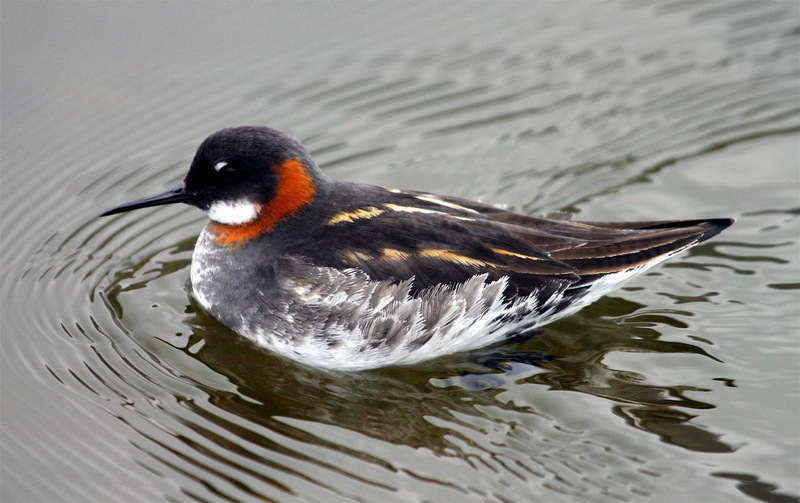|
| Query: bird | Result: 2772nd of 32675 | |
Red-necked Phalarope (Phalaropus lobatus) - wiki
| Subject: | Red-necked Phalarope (Phalaropus lobatus) - wiki
| |

| Resolution: 1162x731
File Size: 313256 Bytes
Date: 2006:06:18 17:49:09
Camera: Canon EOS 300D DIGITAL (Canon)
F number: f/5.6
Exposure: 1/400 sec
Focal Length: 350/1
Upload Date: 2007:08:27 10:32:49
|
Red-necked Phalarope
From Wikipedia, the free encyclopedia
[Photo] Red-necked Phalarope, Phalaropus lobatus. Taken in northern Iceland, June 2006. By http://en.wikipedia.org/wiki/User:Psychofox
The Red-necked Phalarope, Phalaropus lobatus, is a small wader. This phalarope breeds in the Arctic regions of North America and Eurasia. It is migratory, and, unusually for a wader, winters at sea on tropical oceans.
Red-necked Phalarope is about 18 cm (7 in) in length, with lobed toes and a straight, fine bill. The breeding female is predominantly dark grey above, with a chesnut neck and upper breast, black face and white throat. The breeding male is a duller version of the female. They have lobed toes to assist with their swimming. Young birds are grey and brown above, with buff underparts and a black patch through the eye. In winter, the plumage is essentially grey above and white below, but the black eyepatch is always present. They have a sharp call described as a whit or twit.
The typical avian sex roles are reversed in the three phalarope species. Females are larger and more brightly coloured than males. The females pursue males, compete for nesting territory, and will aggressively defend their nests and chosen mates. Once the females lay their eggs, they begin their southward migration, leaving the males to incubate the eggs and look after the young. Three to seven eggs are laid in a ground nest near a marshy area. The young mainly feed themselves and are able to fly within 20 days of birth.
When feeding, a Red-necked Phalarope will often swim in a small, rapid circle, forming a small whirlpool. This behaviour is thought to aid feeding by raising food from the bottom of shallow water. The bird will reach into the center of the vortex with its bill, plucking small insects or crustaceans caught up therein. On the open ocean, they are often found where converging currents produce upwellings. During migration, some flocks stop over on the open waters at the mouth of the Bay of Fundy to take advantage of food stirred up by tidal action.
Almost all of the nonbreeding season is spent in open water. This species is often very tame and approachable.
The Red-necked Phalarope is one of the species to which the Agreement on the Conservation of African-Eurasian Migratory Waterbirds (AEWA) applies.
Red-necked Phalarope in Britain and Ireland
The Red-necked Phalorope is a rare and localised breeding species in the British Isles, which lie on the extreme edge of its world range. The most reliable place for them is the Shetland Isles, particularly the Loch of Funzie on Fetlar, with a few birds breeding elsewhere in Scotland in the Outer Hebrides (e.g. at Loch na Muilne, where a "phalarope watchpoint" has been set up) and sometimes the Scottish Mainland in Ross-shire or Sutherland. They have also bred in western Ireland.
http://en.wikipedia.org/wiki/Red-necked_Phalarope
| The text in this page is based on the copyrighted Wikipedia article shown in above URL. It is used under the GNU Free Documentation License. You may redistribute it, verbatim or modified, providing that you comply with the terms of the GFDL. |
|
Comments |
|---|
| | Guest |
|
Red-necked Phalarope (Phalaropus lobatus)
French: Phalarope à bec étroit German: Odinshühnchen Spanish: Falaropo picofino
Taxonomy: Tringa tobata [sic] Linnaeus, 1758, Hudson Bay, Canada.
Sometimes placed in monospecific genus Lobipes. Monotypic.
Distribution:
Circumpolar, in coastal regions of Arctic Ocean, S to Aleutians and British Is. Winters pelagically off CW South America, in Arabian Sea and from C Indonesia to W Melanesia. |
^o^
Animal Pictures Archive for smart phones
^o^
|
|
|

